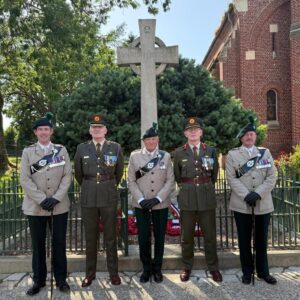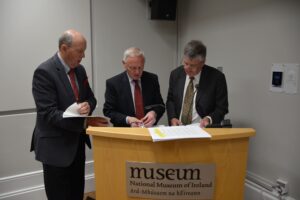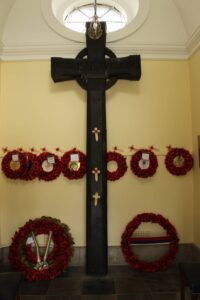
Throughout Ireland, the National Day of Commemoration, An Lá Comórtha Náisiúnta, took place on Sunday, 12 July 2015. The principal event was held at the Royal Hospital in Kilmainham, Dublin. Events were also held in Cork, Kilkenny, Limerick, Sligo and Galway.
The purpose of the commemoration is to remember all those Irish soldiers who lost their lives in war or with the United Nations. The National Day of Commemoration occurs on the Sunday nearest to the 11 July, the anniversary of the date in 1921 when a truce was signed ending the War of Independence.
The first National Day of Commemoration was held on 13 July 1986 in the Garden of Remembrance during which a commemorative plaque was unveiled by President Patrick Hillery. The ceremony was moved to the Royal Hospital in 1987.
The Royal Hospital was built between1680 and 1684 as a hospital for retired soldiers of the British Army. Based on Les Invalides in Paris, it predates the Royal Hospital in Chelsea by two years. It is the oldest neoclassical building in Ireland and was handed over to the Irish Free State in 1922. Since 1991, it is the home of the Irish Museum of Modern Art.
The Commemorative Plaque in the Royal Hospital carries the following inscription: “In honour of all those Irishmen and Irishwomen, who died in past wars, or on service with the United Nations”.
The military and religious ceremonies were held in the presence of the President, the Taoiseach and other members of the Government of Ireland, members of the Oireachtas, the Council of State, the Diplomatic Corps, the Judiciary, the Defence Forces, next-of-kin of those who died on service with the United Nations, Northern Ireland representatives, a wide cross-section of the community, representatives of Regimental Associations and Veterans Associations, and a considerable number of ex-servicemen and ex-servicewomen.
The ceremonies commenced at 1100hrs with the arrival of An tUachtarán Michael D. Higgins and the inspection of a Captain’s Guard of Honour, drawn from the 7 Infantry Battalion, Cathal Brugha Barracks, Dublin under the command of Captain John Moody.
Representatives of the various Faith Traditions in Ireland participated in a multi-faith commemoration.
Music interludes were provided by Ms Cara O’Sullivan and the Army Number 1 Band and Pipers from the School of Music, under the direction of Lieutenant-Colonel Mark Armstrong.
The President laid a wreath on behalf of the people of Ireland. This was followed by a period of one minute’s silence terminated by the firing of a 25 Pounder Gun Howitzer by the
2 Artillery Regiment. Military honours were rendered by a Cadet Guard of Honour, with instrumentalists from the Army Number 1 Band sounding the Last Post and Reveille.
The ceremony was concluded with the playing of The National Anthem and a fly past flown by PC9s from the Air Corps.
View our Gallery of Images from Our Flickr Chananel >>
After the ceremony, the Military Heritage of Ireland Trust CLG hosted a luncheon on behalf of the Department of An Taoiseach. Reinforcing the cross-border nature of the Trust’s activities, attendees included representatives of the National Museum of Ireland, Royal Irish Regiment, Combined Disbanded Irish Regiments Association, Leinster Regiment Association, Royal Irish Regiment Association, the Somme Heritage Centre, the Royal Irish Fusiliers Museum, the Royal Inniskillen Fusiliers Museum, and the RUC Federation.
View the Gallery of Images from Our Flickr Channel >>
In addressing the attendees, the Chairman Brigadier-General Paul Pakenham (Retd) stated, inter alia, “Today, we recall with fondness and respect, all Irish Soldiers who were exposed to the hostile and volatile events that occurred in areas of conflict, including peacekeeping, and especially those who made the ultimate sacrifice. They include Private Patrick Gannon age 27 of the Royal Dublin Fusiliers, son of Bernard and Margaret from Arklow County Wicklow, and Private John Carson of the Kings Own Scottish Border from Whitehall in Belfast, both of whom are commemorated on the Cape Halles Monument in Gallipoli. Having gained only 350 yards in two day’s heavy fighting at Achi-Baba, the Allies withdrew on July 12th. Thereafter, the bulk of Allied operations in Gallipoli was focused further north, around Anzac Cove and Suvla Bay. Privates Gannon and Carson are two of the many Irish Soldiers Killed in Action, on Monday 12 July, 100 years ago, today in the Great War”.
“On the bicentenary of Waterloo, we are reminded of Napoleon’s assessment of the valour of the Inniskillins, holding the square in 1815: “that regiment with the castles on their caps, is composed of the most obstinate mules I have ever saw; they don’t know when they were beaten”. Wellington later said: “They, (the 27th), saved the centre of my line at Waterloo.”




